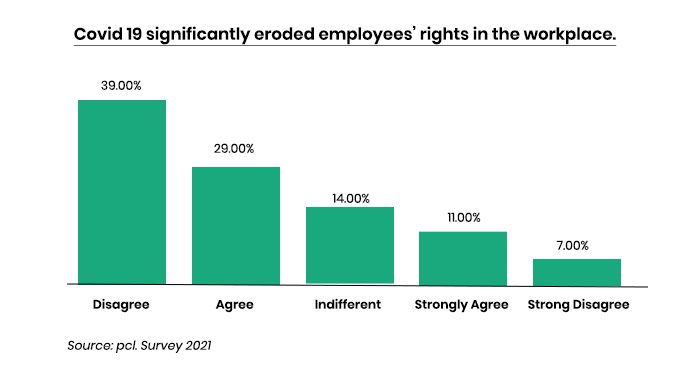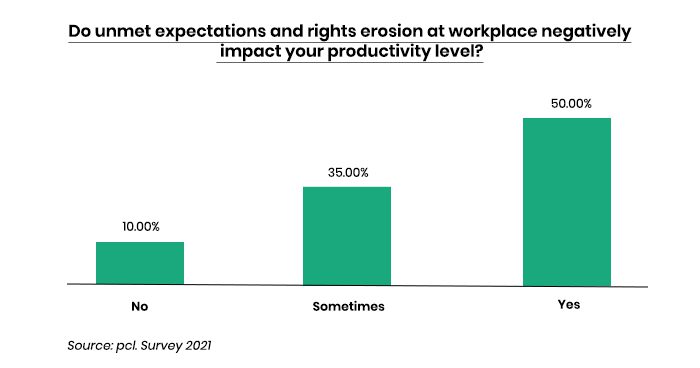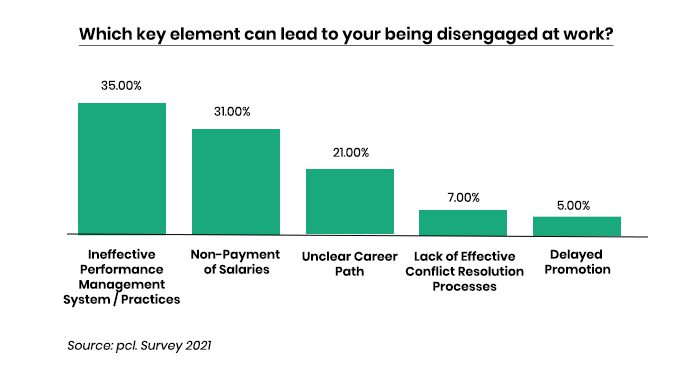In the post-pandemic era of hybrid and fully remote work, employee relationship management has evolved from static Human Resource (HR) practices to dynamic people relationship management that is continuously evolving. Continuous and consistent engagement between the employer and employee to build consensus on processes, outputs, and outcomes is now crucial to organisational performance. In continuously engaging with employees, employers must consider their employees’ rights and interest and how it affects the performance and productivity of the organisation.
Employee rights are those guarantees backed by the organisation’s policies, which are sometimes enshrined in such documents as HR, Financial Management and Safety, etc. Rights are often not subject to negotiations as they are usually fixed unless revised by the organisation for improvement. When employee rights and interests are managed effectively, it leads to increased work performance and drives productivity.
However, interest matters could generate many misunderstandings and conflicts between the employee and the employer. When employees, and usually by their representatives (Unions), consider a matter a pressing issue, they always want to convert this to rights by seeking avenues for discussions and negotiations with the decision-makers.
How rights and interest matters are treated and managed in the organisation may create the atmosphere for either a disruptive or effective work environment that may impact the organisation’s productivity level. Therefore, it is important to understand the nature of right and interest matters in the organisation, fashion out the kind of interactions that will help assure rights and decrease areas of conflicts that interests may degenerate if not effectively managed.
Using data from a recent survey conducted by pcl.’s People Transformation Unit, this article explores how employee rights affect their workplace productivity, which in turn affects organisational performance.
The Common Goals of Productivity in the Workplace
The concept of employee productivity is a point of intersection when it comes to the common interests and goals of the business and its employees for diverse reasons. Employees want to perform and be productive to enjoy the benefits of bonuses and promotions. At the same time, the business is driven to perform for profitability, sustainability, continuity, and opportunity for growth and expansion. Whether established or start-up, organisations want to excel and be profitable to satisfy all their stakeholders.
“Being profitable is tied to organisational performance and employee productivity, and they can be said to be interdependent: one can hardly exist without the other. In other words, a company cannot be productive and unprofitable simultaneously, neither can it be non-productive and profitable.“
The concept of productivity is the core of organisational and individual performance. At a recent MSME Business Global seminar conducted by MSME Africa, three crucial factors for productivity were highlighted: People, Finance and Physical Assets (building, equipment, etc.). People are the heart of the organisation, and effectively managing them is a key processor that ensures that finance and physical assets yield profits.
The quality of an organisation’s people, motivation level, and drive for performance impact the bottom line of any business. Hence people practitioners and business leaders have rightly dedicated more time and resources in recent years to understanding and effectively managing employees for better engagement and effective performance. The challenge for the 21st-century business is how to ensure optimal employee productivity.
The Changing Workforce in the 21st Century is Changing How Productivity is Measured
The workforce mix in the 21st Century is multi-generational (Baby boomers 1946-1964: Gen X: 1965-1980; Millennials: 1981-1996; Gen Z: 1997-2012) and is impacting employee management along the employee life cycle: recruitment, development, appraisal, reward, and exit. The modern-day workforce composition challenges business leaders, psychologists, and even HR managers to rethink employee relations and thereby creatively manage the interactions and diversity that this talent mix brings to the workplace.
Central to workplace performance and productivity is the case for motivation; hence, the challenge for the 21st-century business is ensuring optimal productivity by rightfully motivating and managing employees.
How Organisations Can Achieve Optimal Employee Productivity
In our survey, we found five factors that affect employee productivity and performance.
Exhibit 1: Factors driving employee productivity
1. Fair Treatment: Employers and employees have expectations when going into the contract, as in any business relationship, and when these expectations break down, they can impact performance negatively. Rights are numerous and may differ across organisations and countries, but some basic ones may be common to all.
This involves transparent, equitable measures of performance, reward, discipline, opportunities for growth and development without favouritism or partiality. According to the Survey, 55% of the respondents prioritised “fair treatment” as the most important factor to define ’employee rights.’
It is critical for processes to be put in place to ensure that people get fair treatment at the workplace. An employee should not feel that the organisation lacks equity and fairness in dealing with issues or people. While some employees would express their grievances, more introverted employees may demonstrate passive-aggressive behaviours (withdrawal, mistrust, etc.) that may be detrimental to themselves or others and ultimately become unproductive.
Exhibit 2: Fair treatment of employees enhances seamless workflow
While Covid-19 has changed the way we work and relate with one another in the workplace, most respondents do not believe that the pandemic significantly eroded employees’ rights in the workplace (Exhibit 4). Instead, it is believed that the pandemic promoted the ease of mutual agreement between employers and employees for effective human resource management.
Exhibit 3: The impact of covid-19 on employees’ rights in the workplace
A closer look at why employees opined that the pandemic fosters a better relationship with employers revealed that employees are now more willing to discuss and introduce work-related issues that interest them to improve performance and productivity. For instance, our analysis shows that the majority of the respondents (54.09%) believe that due to the pandemic, employees are better able to bring issues of interest to the table of discussion and reach an agreement for a productive work environment. Compared to the 24.49% who hold a contrary opinion and the 21.43% who remain indifferent.
Again, when employees are indifferent to notifying the employers regarding concerns, it can foster disinterest, lack of trust in leadership, disengagement, and poor performance. This is especially important in cases where such employees handle roles critical to the sustainability of the business.
2. Employee Privacy: From our analysis of the survey, privacy is one of the top interests of employees. Employees want to have their life/information protected and safe. Our survey showed that employees are particular about their privacy protection, as 79% of the respondents agreed that issues around employees’ rights and interests are responsible for distrust and disengagement in an organisation (Exhibit 4).
Exhibit 4: A privacy policy framework for employees
3. Hostile Environment: Employees spend most of their day in the workplace. If an average workday is 8 hours and commuting time to and from work is between 2 to 4 hours daily, one can safely say that employees spend almost 50% of the days and moments of being awake at work. The rest of the time, they are either asleep or with friends, at movies, gym, etc. Given the brief description of an employee’s average day and the pressure for optimal performance, it is only to be expected that employees would have high expectations from employers on creating an environment that can be next to home: warmlines, friendliness, fairness, openness, discipline, and fair treatment.
Our survey shows that employees lose trust (Exhibit 5) when they feel that issues around their interests are not being addressed adequately. A work environment is considered hostile when employees feel oppressed, judged, intimidated or unfairly treated. A hostile environment will hamper employee productivity. According to the survey, 55% of respondents agreed that unmet expectations in the workplace negatively impact their performance. This percentage significantly increases when one considers the 35% that said it ‘sometimes’ impacted their work negatively.
Exhibit 5: Unmet Expectations and rights erosion can make the work environment hostile and counterproductive
4. Communication and Collective Bargaining: When employees and employers can reach conclusions on matters of common interest, it is usually based on the ability and willingness of the parties involved to communicate with understanding. Findings from the pcl. survey showed that 57% of respondents agreed that the employees’ unionisation is beneficial to the workers due to the ability to drive effective collective bargaining and improved employee welfare.
5. Periodic Review of Compensation: Despite all the issues and concerns surrounding employee productivity in line with their interests in the workplace, the same question was reversed to pinpoint elements that could lead to the employee becoming disengaged in the workplace. In the survey, ineffective performance management systems/practices rank top of the list of the factors that can lead to employees disengagement. Specifically, 66% of respondents indicated that ineffective performance management practice and non-payment of salaries are the top two factors leading to employee disengagement (Exhibit 6).
Exhibit 6: Employees’ Disengagement at Work
Most employees perceive performance management, especially the appraisal process itself, as pivotal to their progression in an organisation. Another key reason why ‘ineffective performance management’ ranks top could be traceable to the fact that it also impacts rewards and compensation reviews.
Now beyond rewards and compensation management, employers’ actual non-remittance of statutory obligations and benefits greatly impacts employee engagement. The concept of compensation, rewards, benefits are all interchangeable in the minds of employees, so when we asked in our survey if “an employer should be considered as defaulting in its statutory responsibilities … when they fail to remit them, whether during or post-employment”, the response was unmistakably clear. Other factors that can trigger disengagements of employees include unclear career paths, lack of effective conflict resolution processes and delayed promotion.
In conclusion, how the outcomes of the organisation and individual performance are managed and used to inform Human Resources actions will have an implication on the promotion of the culture of inclusion, performance, and effective productivity.
Written by:
 |
 |
| Esther Amoye
Senior Consultant |
Olawanle Moronkeji
Associate Partner, People Transformation |






